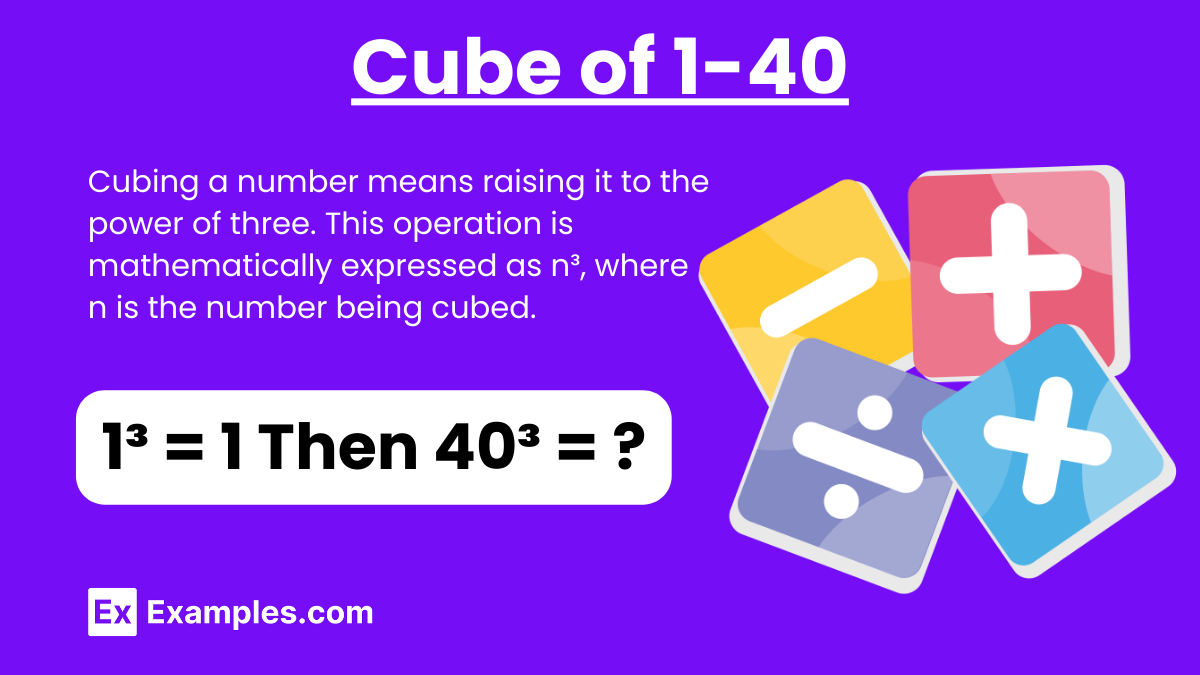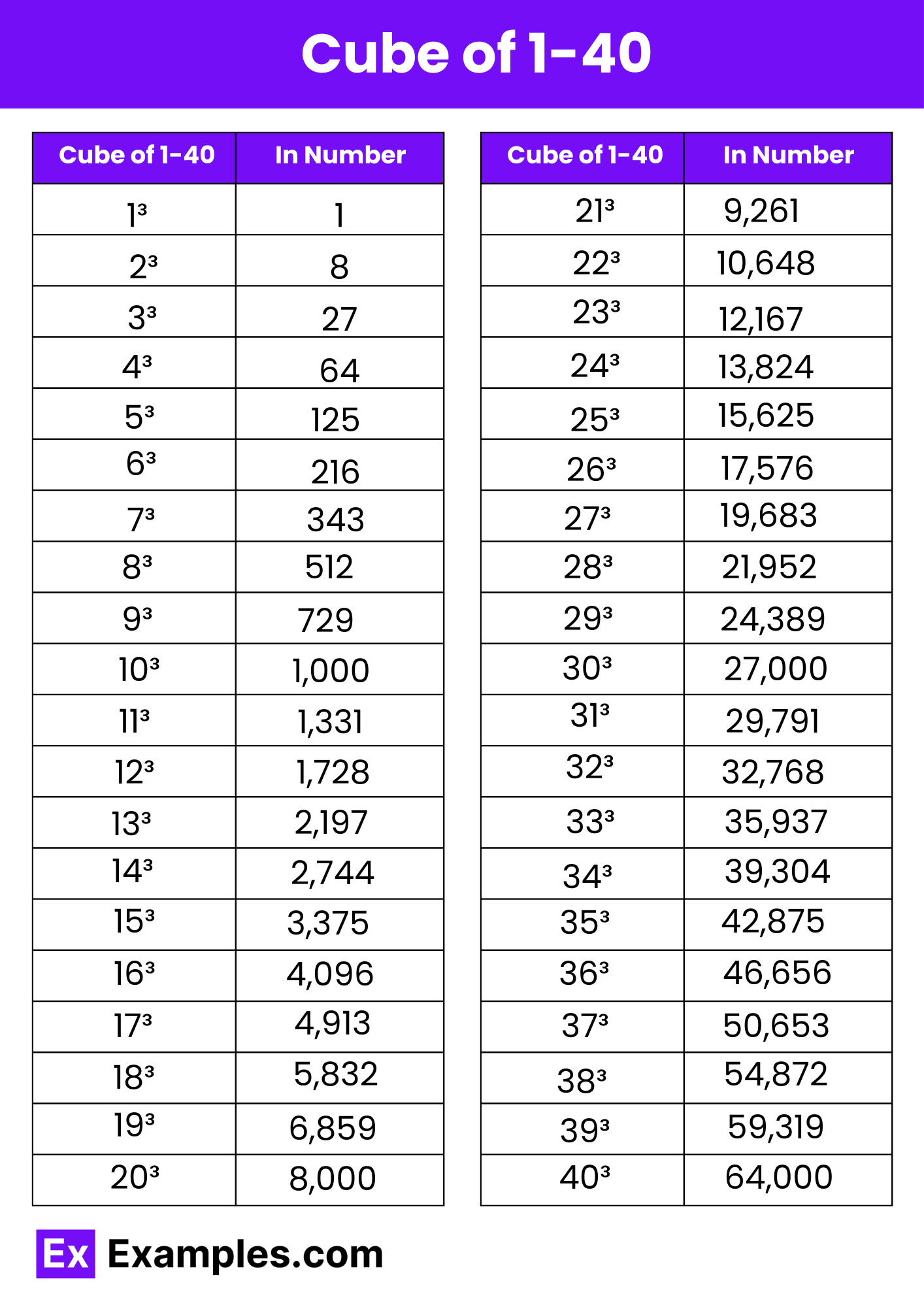What is the cube of 2?
6
8
10
12


Cubing a number means raising it to the power of three. This operation is mathematically expressed as n³, where n is the number being cubed. The cube of a number represents the volume of a cube with sides of length n. For instance, the cube of 2 (which is 2³ or 8) can be visualized as a cube with each side measuring 2 units, resulting in a volume of 8 cubic units.
Understanding cubes is crucial for solving problems related to volume, polynomial equations, and higher-dimensional geometry. It provides a solid foundation for more advanced mathematical concepts and applications in physics, engineering, and computer science.
Below is a table presenting the cubes of numbers from 1 to 40. Each entry includes the number, its cube in numerical form, and the cube written out in words. This comprehensive representation aids in visualizing and memorizing cube values, fostering a deeper understanding of the concept.

| Cube of 1-40 Values | In Number | In Words |
|---|---|---|
| 1³ | 1 | One |
| 2³ | 8 | Eight |
| 3³ | 27 | Twenty-seven |
| 4³ | 64 | Sixty-four |
| 5³ | 125 | One hundred twenty-five |
| 6³ | 216 | Two hundred sixteen |
| 7³ | 343 | Three hundred forty-three |
| 8³ | 512 | Five hundred twelve |
| 9³ | 729 | Seven hundred twenty-nine |
| 10³ | 1,000 | One thousand |
| 11³ | 1,331 | One thousand three hundred thirty-one |
| 12³ | 1,728 | One thousand seven hundred twenty-eight |
| 13³ | 2,197 | Two thousand one hundred ninety-seven |
| 14³ | 2,744 | Two thousand seven hundred forty-four |
| 15³ | 3,375 | Three thousand three hundred seventy-five |
| 16³ | 4,096 | Four thousand ninety-six |
| 17³ | 4,913 | Four thousand nine hundred thirteen |
| 18³ | 5,832 | Five thousand eight hundred thirty-two |
| 19³ | 6,859 | Six thousand eight hundred fifty-nine |
| 20³ | 8,000 | Eight thousand |
| 21³ | 9,261 | Nine thousand two hundred sixty-one |
| 22³ | 10,648 | Ten thousand six hundred forty-eight |
| 23³ | 12,167 | Twelve thousand one hundred sixty-seven |
| 24³ | 13,824 | Thirteen thousand eight hundred twenty-four |
| 25³ | 15,625 | Fifteen thousand six hundred twenty-five |
| 26³ | 17,576 | Seventeen thousand five hundred seventy-six |
| 27³ | 19,683 | Nineteen thousand six hundred eighty-three |
| 28³ | 21,952 | Twenty-one thousand nine hundred fifty-two |
| 29³ | 24,389 | Twenty-four thousand three hundred eighty-nine |
| 30³ | 27,000 | Twenty-seven thousand |
| 31³ | 29,791 | Twenty-nine thousand seven hundred ninety-one |
| 32³ | 32,768 | Thirty-two thousand seven hundred sixty-eight |
| 33³ | 35,937 | Thirty-five thousand nine hundred thirty-seven |
| 34³ | 39,304 | Thirty-nine thousand three hundred four |
| 35³ | 42,875 | Forty-two thousand eight hundred seventy-five |
| 36³ | 46,656 | Forty-six thousand six hundred fifty-six |
| 37³ | 50,653 | Fifty thousand six hundred fifty-three |
| 38³ | 54,872 | Fifty-four thousand eight hundred seventy-two |
| 39³ | 59,319 | Fifty-nine thousand three hundred nineteen |
| 40³ | 64,000 | Sixty-four thousand |
Understanding the cubes of numbers from 1 to 40 is a crucial part of mathematical education. Cubing, which involves raising a number to the power of three, is fundamental in various mathematical disciplines and practical applications. Whether you’re calculating the volume of geometric shapes, solving polynomial equations, or exploring higher-dimensional mathematics, knowing the cube values provides a strong foundation.
The table presented, which includes the cubes of numbers from 1 to 40 in both numerical and word forms, serves as a valuable reference. It facilitates quick look-ups and aids in the visualization and memorization of these values.
Mastering the cubes of these numbers enhances your mathematical proficiency and prepares you for more complex topics in mathematics, science, and engineering. This foundational knowledge is indispensable for students, educators, and professionals who frequently engage with mathematical concepts and their real-world applications.
Text prompt
Add Tone
10 Examples of Public speaking
20 Examples of Gas lighting
What is the cube of 2?
6
8
10
12
What is the cube of 5?
100
125
150
175
What is the cube of 7?
343
357
371
387
Which of the following is the cube of 4?
12
16
37
64
What is the result of cubing 8?
512
516
522
545
Which of these is the cube of 10?
800
900
1000
1100
What is the cube of 14?
1960
2744
2048
2401
Which number represents the cube of 20?
8000
9000
10000
11000
Determine the cube of 25.
12500
10000
17500
15625
Find the cube of 35.
42875
35000
40000
48000
Before you leave, take our quick quiz to enhance your learning!

